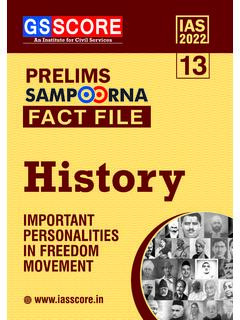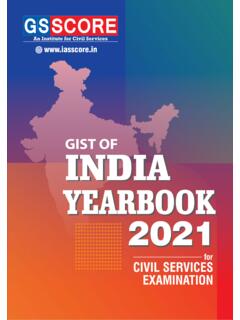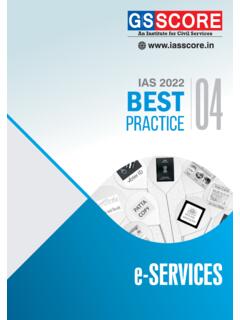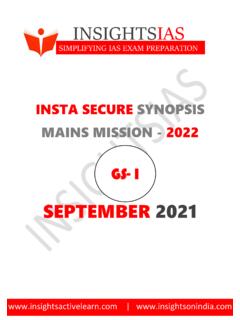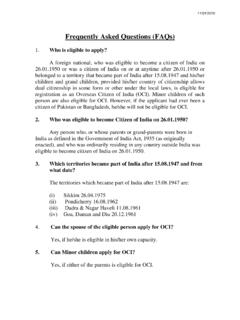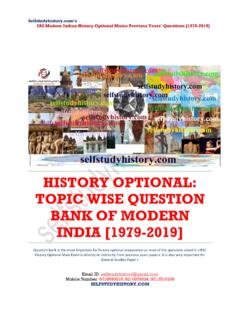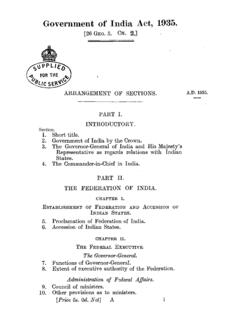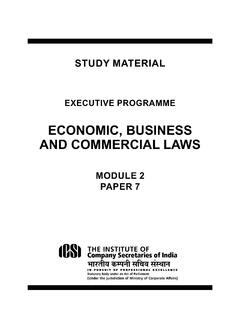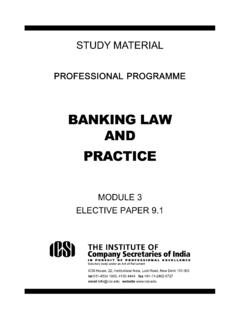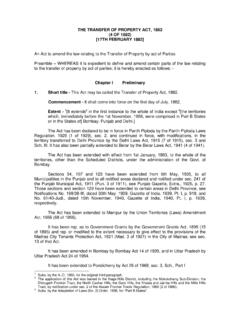Transcription of UPSC Syllabus 2021 - Iasscore
1 Syllabus 2020-21 Pre Historic Cultures In India1. Periodization of Indian pre history " Sources of pre history " Stone age " Paleolithic (2 million BC 10,000 BC) Mesolithic (10,000 BC 8,000 BC) Neolithic (8000 BC 4000 BC) Chalcolithic Age (4000 BC 1500 BC) " Iron age (1500 BC-200 BC) " Impact of Iron " Pastoral and Farming Communities2. Neolithic Phase " Chalcolithic Phase " Early Iron Phase " Geographical Distribution and " CharacteristicsIndus Valley Civilization3. Major Cities Town Planning " Harappan Trade " Agriculture " Domestication of animals " Crafts " Religion " Harappan Pottery " Weights and Measures " Script and Language " Images " Decline of Harappan Culture " Vedic Society4. Original Home of Aryans " Features of Aryan Culture " Vedic Texts " Sources for Reconstructing " Vedic Society and Culture Geography of the Rig Vedic Period " and geography of the later Vedic PhasesEconomic Conditions " Political Organisation and Evolution " of Monarchy Social Organisation and Varna System " Religion and Thought " Pre Mauryan Period5.
2 Formation of states " The Sixteen Mahajanapadas " Republics " Rise of urban centres " Haryanka dynasty " Shishunaga dynasty " Nanda dynasty " The Mauryan Empire 6. Chandragupta and Bindusara " Megasthenes " Asoka and His Successors " Asoka s Inscriptions and Sites " Asoka a Dhamma " Mauryan. Administration, Economy, " Society and Art The Arthasastra " Post-Mauryan india (sc 200-AD 300)7. Society: Evolution of Jatis " Sangam Texts-and Society " Satavahanas and Other Indigenous " Dynasties Foreign Dynasties " ANCIENT Syllabus 2020-21 Central Asian Politics and the 1. Advance of Babur towards IndiaThe Timurids " The Timurid-Uzbek and Uzbek-Iran " Confl ict and BaburBabur s Advance towards india " Struggle for Empire in North- india 2. (Afghans, Rajputs and Mughals)Struggle between Ibrahim " Lodi and Baburthe Battle of Panipat " Babur s problems after the Battle " of PanipatStruggle with Rana Sanga " Problems of the Eastern Areas " and the Afghans Babur s Contribution and Signifi cance " of his Advent into IndiaStruggle for Empire in North India3.
3 Humayun and the Afghans " Early Activities of Humayun, " and the Tussle with Bahadur ShahThe Gujarat Campaign " The Bengal Campaign, and Struggle " with Sher KhanThe Establishment of the North 4. Indian EmpireThe Surs " Sher Shah s Early Life " Social and Political Background of Bihar " and the Rise of Sher Shah to Sur Empire (1540-56) " Contributions of Sher Shah " Consolidation and Expansion of the 5. Empire - AkbarConfl ict with the Afghans - Hemu " Struggle with the Nobility: Bairam Khan s " Regency; Revolt of Uzbek Nobles " Early Expansion of the Empire " (1560-76) - Malwa, Garh-Katanga, Rajasthan, Gujarat, Eastern IndiaRelations with the Rajputs - " Growth of a Composite Ruling ClassRebellions, and Further Expansion " of the Empire in the North WestState and government under Akbar6.
4 Akbar s Concept of Suzerainty " Structure of government , " Central and Provincial - the Vikalat, the Central Ministries, ProvincialGovernment, District and " Local GovernmentCommercial Contacts with the Outside World " Schools of Art " Growth of Jainism and Buddhism8. Jainism " Buddhism " Imperial Guptas9. Sources of Gupta Rule " Political history of Guptas " Fahien " Gupta Administration " Gupta Culture " Urban centres in Gupta period " Economic Conditions " Harshavardana10. Sources for Harsha s Period " Early life of Harsha " Harsha s Administration " Important Offi cials of the empire " Economy under Harsha " Society " Religion " The Southern Dynasties11. The Shathavahanas (230 BC TO AD 225) " The Pallavas (AD 330 796) " The Chalukyas (AD 535 1190) " The Pandyas of Madurai (AD 590 1323) " The Chola Dynasty (AD 850 1310) " Rashtrakutas (AD 753 973) " MEDIEVAL india Syllabus 2020-21 The Working of government - the Ruler, " Land-Revenue System, the Dahsala System, the MansabdariSystem and the Army Akbar s Religious Views7.
5 Relations with the Ulama and " Social ReformsThe Early Phase (1556-73) " The Second Phase (1573-80) - " the Ibadat KhanaDebates - the Mahzar - Breach " with OrthodoxUlama - Re-organisation of " Madadd-i-Maash Grants Third or Final Phase - Din-i-Ilahi - State " Policies and religious toleration " The Deccan and the Mughals 8. (Upto 1657)The Deccani States upto 1595 " Mughal Advance towards the Deccan " Mughal Conquest of Berar, Khandesh " and Parts of AhmadnagarRise of Malik Ambar, and Frustration of " Mughal Attempt at Consolidation " (1601-27)Extinction of Ahmadnagar, " Acceptance of MughalSuzerainty by Bijapur and Golconda " Shah Jahan and the Deccan (1636-57) " Cultural Contribution of the " Deccani StatesForeign Policy of the Mughals9. Akbar and the Uzbeks " The Question of Qandahar and " Relations with IranShah Jahan s Balkh Campaign " Mughal - Persian Relations - " the Last PhaseIndia in the First Half of the 10.
6 Seventeenth CenturyJahangir s Accession - his Early " Diffi cultiesTerritorial Consolidation and Expansion " of the Empire - Mewar, East india and KangraNur Jahan, and the Nur Jahan Junta " The Rebellions of Shah Jahan, and " the coup de main of Mahabat KhanJahangir as a Ruler " State and Religion in the First Half " of the Seventeenth CenturyShah Jahan - Consolidation and " Expansion of the EmpireEvolution of the Mughal Ruling Class " and the Mansabdari SystemAurangzeb - Religious Policies, 11. North india and the RajputsWar of Succession " Religious Policy : First Phase (1658-79) " Reforms and Puritanical Measures, Hindu " Temples, Jizyah; Second Phase " (1679-1707)Territorial Consolidation and " Expansion of Empire - North IndiaPopular Revolts - Jats, Satnamis, " Afghans and SikhsBreach with Marwar and Mewar " Climax and Crisis of the Mughal 12.
7 Empire the Marathas and the DeccanRise of the Marathas - Early Career " of Shivaji -Treaty of Purandar - the Agra Visit " Shivaji s Swarajya - Administration " and AchievementsAurangzeb and the Deccani States " (1658-87)Marathas and the Decean (1687-1707) " Assessment of Aurangzeb and the " Jagirdari CrisisSociety-Structure and Growth13. Rural Society " Towns and Town Life " Artisans and Master-Craftsmen " Women " Servants and Slaves " Standard of Living " The Ruling Classes - Nobility, " Rural GentryThe Middle Strata " The Commercial Classes " Economic Life-Patterns and 14. ProspectsInland Trade " Overseas Trade - Role of Foreign Trading " Companies - Position of Indian " Merchants Over-land Syllabus 2020-21 The Mughal State and Commerce " Trend of india s Economy and Prospects " during the First Half of the Eighteenth CenturyReligion, Fine Arts, Science and 15.
8 Technology Religion- Hindu Religion, Sikh Religion, Islam " Fine Arts - Architecture, Painting, Language " and Literature, MusicScience and Technology " Northern india in the First Half of 16. the Eighteenth CenturyBahadur Shah I, and the Beginning " of the StruggleFor Wizarat - Rajput Affairs - Marathas " and theDeccan - Accentuation of the " Party StruggleStruggle for New Wizarat: Zulfi qar Khan " and Jahandar Shah (1712-13)The Saiyid Brothers Struggle for " New WizaratThe Saiyid New Wizarat " The Wizarat of M. Amin Khan and " Nizam-ul-MulkRise of Regional States, Beginning " of Foreign Invasions of india (1725-48)The Maratha Bid for Supremacy17. The Marathas and their Policy " of ExpansionThe Marathas and Nizam-ul-Mulk " The Maratha Advance into Gujarat " and MalwaThe Maratha Advance into Doab " and Punjab:First Phase (1741-52); Second Phase " (1752-61);Third Battle of Panipat " Scenario before 18571.
9 Later Mughals " Regional powers in 18th Century " The British conquest of india " The wars during British conquest of india " British Administration before 1857 " Revolt of 18572. Indian National Movement (1858-1905) " Early Nationalists and Swadeshi Movement " government of india Act 1909 " Home rule league movement " The struggle for Swaraj3. Montague s statement Aug 1917 " Emergence of Gandhi as a mass leader " Khilafat & Non-Cooperation Movement " (NCM)Swaraj Party " Revolutionary Terrorism phase II (1920 s) " Simon Commission and Nehru report " Intimation of freedom4. Civil Disobedience Movement " Round table conference " Poona pact " government of india Act 1935 " Tripuri session 1939 " August offer " Individual Satyagarha 1940-41 " Towards achievement of freedom5. Popular struggles in the princely states " 2nd World War and Nationalist response " Partition of India6.
10 Rise of Communalism " Wavell plan " Cabinet Mission Plan " Mountbatten plan " During the freedom struggle7. Indian renaissance/socio-religious movement " Civil Rebellions during British " Tribal movements during British period " MODERN Syllabus 2020-21 POST INDEPENDENCE INDIARe-organisation of states1. Constitutional provisions related " to State formationFactors that lead to merger " Accession of the princely states " Accession of States under France " and PortugueseAccession of Sikkim " Rehabilitation of the Refugees " Federal crisis "Regional aspirations, insurgencies and " areas of tensionAccommodation and national integration " Linguistic Regionalism In India2. Constitutional position and language policyLanguage and regionalism Recent controversy due to rise of Hindi Tribal Issue And Policy 3.


